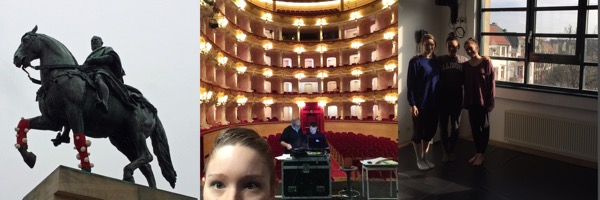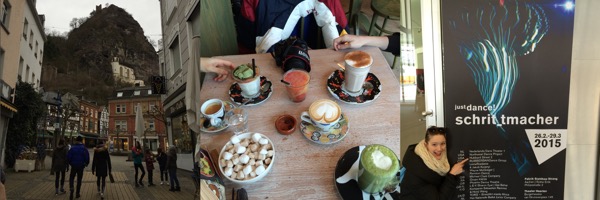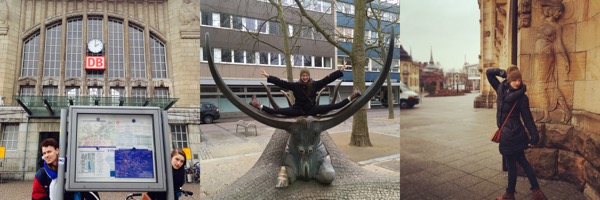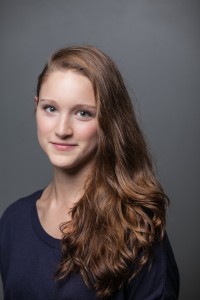
by Andrea Thompson
After a whirlwind tour of three central European countries in late February and early March, regular 4dancers contributor and Hubbard Street 2 Dancer Andrea Thompson found a quiet spot and answered some questions about the experience.
Where did you go?
We flew into Frankfurt and drove around Germany to perform in Rüsselsheim, Landau, Aschaffenburg, Idar-Oberstein and Essen. After that we drove across the border to Heerlen in the Netherlands, and then flew to our last stop in Treviso, Italy.
How long did you stay in each city?
Just long enough to arrive and sometimes have a workshop that day, then tech and perform the following day. We stayed longer in Rüsselsheim because we had an acclimation day there when we landed, and we had a day off in Landau as well.
What was a typical day on tour like?
On show days, our call at the theater would be around 11:30am or noon, so we would go warm up and have ballet class. Then we’d run cues with our awesome stage manager Julie Ballard and tech through the show to find our spacing and lighting, figure out entrances and exits through the wings in each new space, and get notes from Hubbard Street 2 Artistic Director Terence Marling — we call him “Terry.” Once all that was done, we usually had two or three hours until showtime, so generally some of us would stay inside the theater and others would step out for a bit. Around show number three we started making time beforehand to do an “improv soup,” à la Bryan Arias, to warm up and connect with each other before the house opened. These got pretty ridiculous, with some new ingredients including “star in your own music video,” “robot catwalk,” “first-person shooter game,” and “pick a note and say ‘Ah.’” But they were a great way to get moving and get sweaty, fast. Most other days of the tour involved checking out of our hotel, driving to the next city, checking into a new hotel, and then half of us going to a workshop with Terry while the other half explored the town and scouted a place for dinner. Exploration activities varied depending on the city; sometimes there were castles to check out, other times parks, cafés, or local street art.
Which was your favorite theater?
The Stadthalle am Schloss in Aschaffenburg is really spacious, which was great to dance on. But the light coming through the windows in at the Jugendstil-Festhalle in Landau was beautiful during our warmup class, and the house of the Teatro Comunale Mario del Monaco in Treviso is gorgeously decorated — the building opened in 1869, and the ceiling mural and plush seating reflect that time period, still. The staff at the Parkstad Limburg Theaters in Heerlen was really spectacular… They were all such unique experiences, I don’t think I can choose an overall favorite!

Which was your favorite city?
Idar-Oberstein was so unique — a little creepy at times, but definitely had a lot of rocky character: It’s an important contributor to the gemstone industry, so there are rock and jewelry stores and museums everywhere. Landau was beautiful but rainy while we were there, which puts Aschaffenburg in the lead as the most magical due to the presence of what appeared to be ancient castle ruins in Park Schöntal, which I casually happened upon during a pre-show stroll outside at sunset. But then again, Heerlen had Bagels and Beans — a delicious and healthy coffee shop — and free wi-fi everywhere, which was hugely convenient for us foreigners. Being in Treviso marked my first time ever going to Italy, so that was a pretty special stop for me as well.
Which was your favorite performance?
I’d have to say Aschaffenburg. It was our third show, and felt like we really hit our stride — we were finally truly done adjusting from jetlag, and it was amazing to occupy such a huge space. That was the first time I felt like I could relax and enjoy being in the unique environment of each piece without being distracted by some aspect of my surroundings or the state of my body. But then again, I think everyone in HS2 was extra-determined to give the people of Idar-Oberstein the show of their lives. It was a small stage with barely any wings, and it was a little raked: tilted toward the audience, instead of perfectly flat. None of us had danced on a raked stage before so we were super-conscious of it and tried extra-hard not to let it shrink our movement or make us appear cautious. That was a particularly “live” show: Things felt significantly different in that space than they had in the studio but we were especially present and aware of each other, knowing we had a lot to pay attention to. It was exciting, and I feel like I learned a lot about performing, both from my experience and from watching my peers through the wings during that show.
How were your shows received by your audiences?
I think well, for the most part, to gauge from the talkbacks following our shows in Germany, and from the number of curtain calls we received. In Idar-Oberstein, our post-show discussion was very quiet, but then this cute couple in their fifties or sixties waited for us outside the stage door to get our autographs and asked us a ton of questions. They really loved the show and said they hadn’t ever seen dance like that before, and that they felt emotionally connected to the works. Our lecture-demonstration at the Amerikahaus Ruhr in Essen garnered a great audience response as well, which led to an extensive conversation and reception after. There was an interactive part of our showing there which involved each of us grabbing a partner from the audience to come up on stage and “mirror” our movements. That seemed to add a personal layer of interest for those who came up to dance with us, and many sought out their HS2 partners during the reception to talk about the experience. After our show in Heerlen, in Holland, the applause seemed especially thunderous, and to our complete surprise and delight we received flowers onstage during our bows. As we were leaving the theater we ran into some people from the audience who wanted to take photos with us, and they let us know that they really enjoyed the show.

What was the best thing you ate?
The salad I got my first night in Treviso was beautiful and so delicious. German breakfasts were always lovely — our hotel in Rüsselsheim had a lavish spread with vegetables, eggs, cheeses, salads, meats, fish, bread rolls, muesli, yogurt… Everything you could ever want to eat before noon with unlimited coffee to boot. The authentic German meal I shared with Katie [Kozul] in Idar-Oberstein is also high up on the list, as is every meal I ate at Bagels and Beans in Heerlen.
What was the coolest non-dance thing you saw or did?
On a day off while the rest of HS2 was traveling between cities, Adrienne [Lipson], Zach [Enquist] and I went to Darmstadt to see our friend Tyler Schnese perform in his first season with Hessisches Staatsballett. The theater was huge and high-tech and his dancing was incredible. We were pretty proud of ourselves for surviving an outing alone, and I loved the feeling of conquering the German train system: Barely making it on the right train still counts as making it! Idar-Oberstein offered a gorgeous hike up a mountain to the Schloss Oberstein, the castle overlooking the city. It felt like we were going back in time hundreds of years and/or potentially entering the set of The Lord of the Rings. The architecture outside and the art overflowing in the San Nicolò cathedral in Treviso was breathtaking, as was flying over the Swiss Alps on the way home!
Tell us about your favorite interaction with a local.
On our acclimation day, I led almost all the dancers of HS2 into Frankfurt for a “profi-training” class: week-long, once-a-day workshops for professional dancers led by a rotating schedule of teachers for only four Euros. We were fresh off the plane and had to leave our hotel super early in order to groggily walk 45 minutes to the train station, ride into Frankfurt, and find the studio which I had been to once before on a previous trip…and was mostly confident I could find again. None of us were expecting to see any familiar faces at this class which seemed like a local secret, tucked away in the Künstlerhaus Mousonturm, but to our surprise, there was a German friend whom Zach, Adrienne and I knew from the Springboard Danse program in Montréal! We grabbed coffee with him after class, introduced him to the rest of HS2, and caught up. His suggestion to wander toward the river in Frankfurt was a great one on that sunny day. But in addition to finding him there, another cool interaction was talking to the other participants of the class, who turned out to be mostly assorted dance students of the university in Frankfurt. They were so sweet and curious about Chicago, and they wished us well on our tour. In the end though, the winner of “favorite local” award may be a happy little white dog we met by the River Main in Frankfurt. He was cute, loud, and oh so saucy.

What was the most unusual or surprising experience you had?
Everything about our hotel in Idar-Oberstein was unusual: Ominous-sounding church bells marked every hour, there was a resident parrot who squawked and laughed through breakfast, and there were portraits and eclectic animal figurines everywhere. In addition to the giant cuts of crystallized stone in the corners of the staircase that were almost as large as the suitcase I struggled to carry past them, portraits of infants lined the halls, with eyes that seemed to follow you as you moved. Adrienne and I heard a baby crying on our first night and could only logically assume it came from the artwork.
What was your biggest takeaway from the tour?
The most important thing I learned from this tour was that performing is about being present. It sounds obvious, but when I thought about what made certain shows feel so great, it always came down to being engaged in the current moment: being truly there with my friends and colleagues onstage, acknowledging the audience, and being realistic about the space I was in. I felt the best when I left doubt and judgment outside the theater and took trust and confidence onstage with me. The most incredible moments of performance happened when I allowed myself to drop fully into the world my fellow dancers and I were creating onstage. In those moments I know we shared something specific and beautiful with our audiences: ourselves.
On April 16 at Highland Park High School, Hubbard Street 2 performs on Dance Night during the 25th anniversary celebration of Focus on the Arts; a master class will also be offered. On May 2 at Symphony Center in downtown Chicago, Hubbard Street 2 performs as part of a “Tchaikovsky Spectacular” in the Chicago Symphony Orchestra’s Family Matinée Series; special activities begin one hour prior to the performance, which starts at 11am. On May 9, Hubbard Street 2 performs in the Sibert Theatre at Illinois College in Jacksonville. For a complete HS2 touring schedule, artist profiles and more, visit hubbardstreetdance.com.
 Contributor Andrea Thompson (Maplewood, NJ) trained at the New Jersey School of Ballet, American Ballet Theatre’s Jacqueline Kennedy Onassis School and the Ailey School in New York City. Thompson has also studied at the Juilliard School, Northwest Professional Dance Project, Springboard Danse Montréal, Nederlands Dans Theater and Batsheva Dance Company, which brought opportunities to perform choreography by Gregory Dolbashian, William Forsythe, Natalia Horecna, Jessica Lang, Marina Mascarell, Idan Sharabi, Robyn Mineko Williams, Paul Lightfoot and Sol León. At the San Francisco Conservatory of Dance, under the direction of Summer Lee Rhatigan, she trained with and performed works by Christian Burns, Alex Ketley, Thomas McManus, Robert Moses, Ohad Naharin, Alessio Silvestrin and Bobbi Jene Smith. Thompson joined Hubbard Street 2 in August 2013, following work in San Francisco and New York with Zhukov Dance Theatre, Chang Yong Sung, LoudHoundMovement, Backwoods Dance Project and the Foundry.
Contributor Andrea Thompson (Maplewood, NJ) trained at the New Jersey School of Ballet, American Ballet Theatre’s Jacqueline Kennedy Onassis School and the Ailey School in New York City. Thompson has also studied at the Juilliard School, Northwest Professional Dance Project, Springboard Danse Montréal, Nederlands Dans Theater and Batsheva Dance Company, which brought opportunities to perform choreography by Gregory Dolbashian, William Forsythe, Natalia Horecna, Jessica Lang, Marina Mascarell, Idan Sharabi, Robyn Mineko Williams, Paul Lightfoot and Sol León. At the San Francisco Conservatory of Dance, under the direction of Summer Lee Rhatigan, she trained with and performed works by Christian Burns, Alex Ketley, Thomas McManus, Robert Moses, Ohad Naharin, Alessio Silvestrin and Bobbi Jene Smith. Thompson joined Hubbard Street 2 in August 2013, following work in San Francisco and New York with Zhukov Dance Theatre, Chang Yong Sung, LoudHoundMovement, Backwoods Dance Project and the Foundry.




